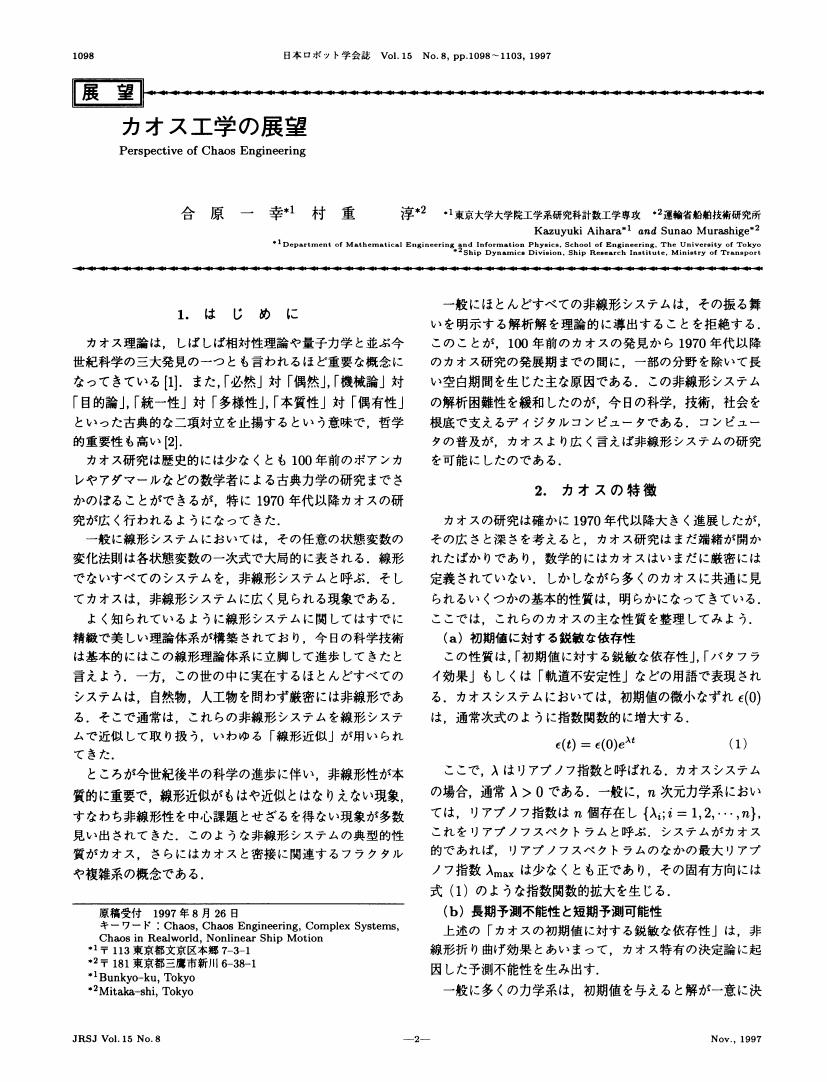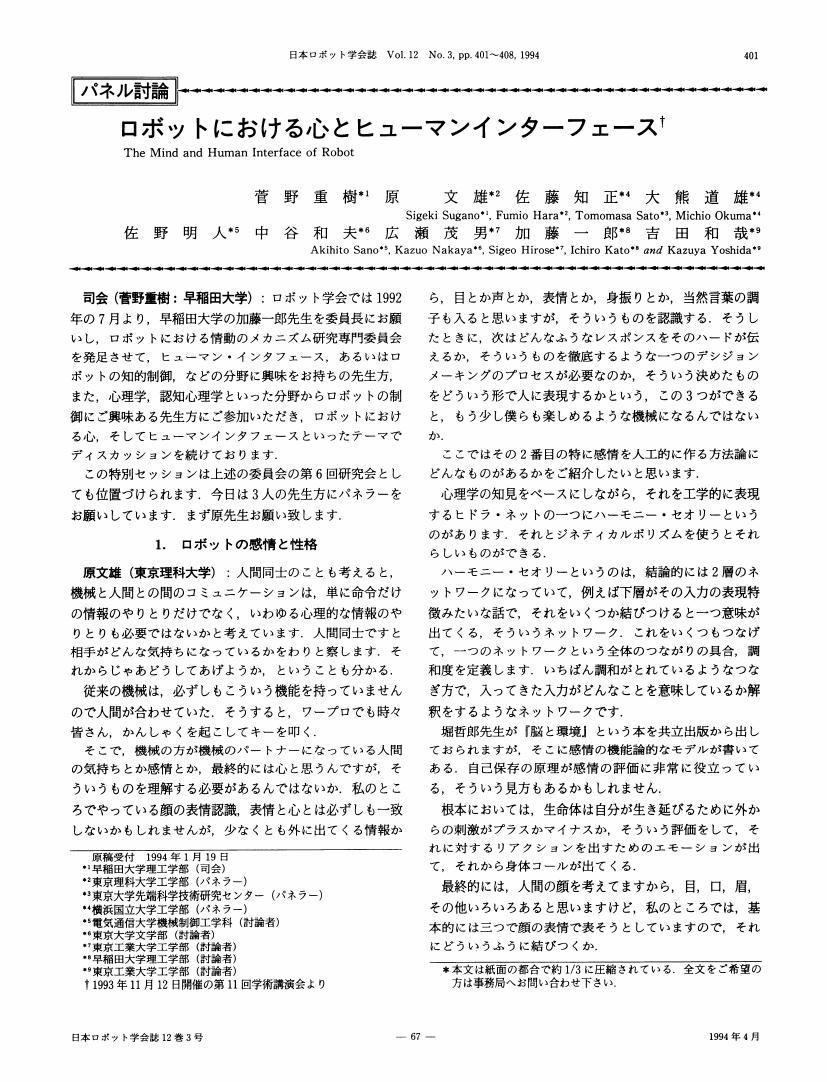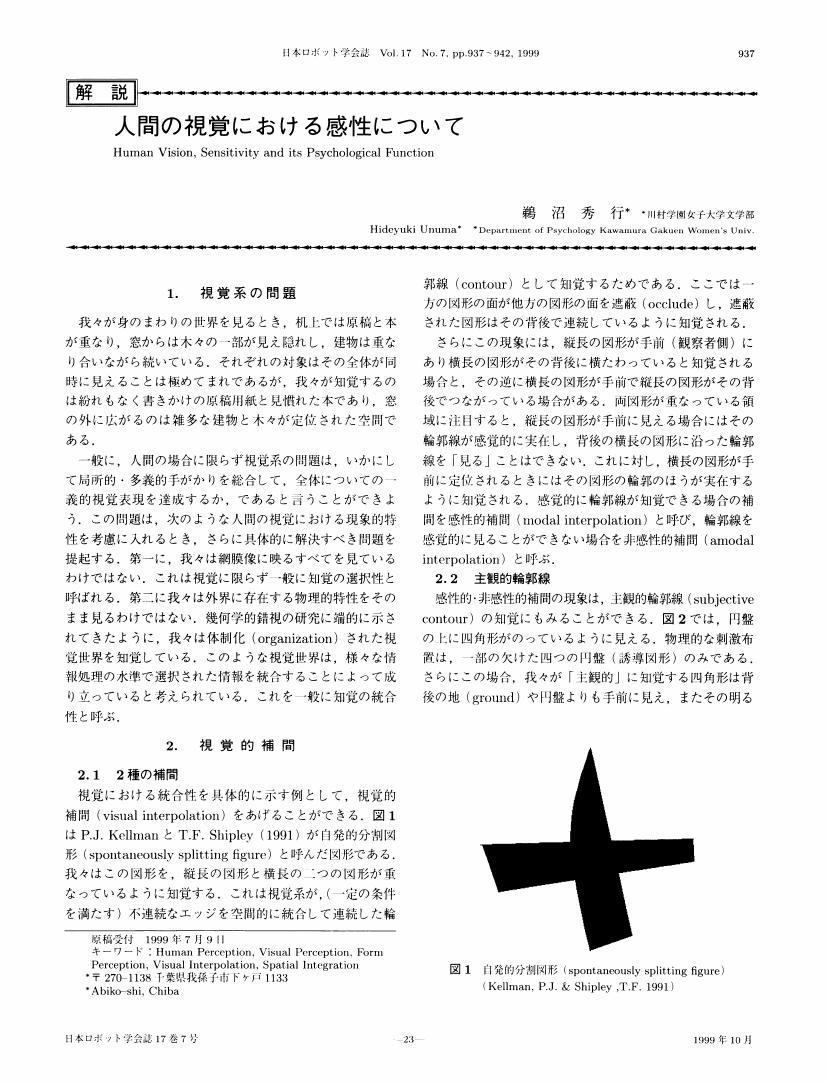- 著者
- 則次 俊郎 安藤 文典 山中 孝司
- 出版者
- The Robotics Society of Japan
- 雑誌
- 日本ロボット学会誌 (ISSN:02891824)
- 巻号頁・発行日
- vol.13, no.1, pp.141-148, 1995-01-15
- 被引用文献数
- 21 13
The number of human requiring the rehabilitation for the fracture of a bone and joint disease caused by the traffic accident and cerebral apoplexy and so on will be increased with the advanced aging society. In the exercise for restoration of function in the rehabilitation, some automatic recovery machines have already been used just for the relatively easy exercise. Moreover, for the complex exercise and evaluation of muscle strength, a multi d.o.f. manipulator is required. However, this kind of robots have not been much developed. Because they require the essential function such as safety and flexibility which are not common in general industrial robots.<BR>In this study, we focus on a rubber artificial muscle and apply 2 d.o.f. manipulator using this actuator to the rehabilitation robot for the exercise for restoration of function. By applying the impedance control scheme containing a two d.o.f. PID control system to a positioning loop, a unified control realizes several exercise motion modes required to the execise and evaluation. Through some experiments of trajectory tracking, compliance, and damping control the satisfactory control performance can be obtained. Further, the proposed control system can realize the all exercise motion modes.
2 0 0 0 知能の社会性
- 著者
- 大澤 真幸
- 出版者
- The Robotics Society of Japan
- 雑誌
- 日本ロボット学会誌 (ISSN:02891824)
- 巻号頁・発行日
- vol.14, no.4, pp.485-489, 1996-05-15
- 被引用文献数
- 2
2 0 0 0 「午前4時」の戦い!
- 著者
- 大須賀 公一
- 出版者
- The Robotics Society of Japan
- 雑誌
- 日本ロボット学会誌 (ISSN:02891824)
- 巻号頁・発行日
- vol.27, no.2, pp.164-167, 2009-03-15
2 0 0 0 エスノメソドロジーに基づくロボット研究
- 著者
- 久野 義徳
- 出版者
- The Robotics Society of Japan
- 雑誌
- 日本ロボット学会誌 (ISSN:02891824)
- 巻号頁・発行日
- vol.29, no.1, pp.27-30, 2011-01-15
- 被引用文献数
- 1 2
- 著者
- 山崎 敬一
- 出版者
- The Robotics Society of Japan
- 雑誌
- 日本ロボット学会誌 (ISSN:02891824)
- 巻号頁・発行日
- vol.29, no.1, pp.10-13, 2011-01-15
- 被引用文献数
- 1
1 0 0 0 OA カオス工学の展望
- 著者
- 合原 一幸 村重 淳
- 出版者
- The Robotics Society of Japan
- 雑誌
- 日本ロボット学会誌 (ISSN:02891824)
- 巻号頁・発行日
- vol.15, no.8, pp.1098-1103, 1997-11-15 (Released:2010-08-25)
- 参考文献数
- 5
1 0 0 0 OA 双輪キャスタ型駆動機構を用いたホロノミック全方向移動ロボット
- 著者
- 和田 正義 高木 昭 森 俊二
- 出版者
- The Robotics Society of Japan
- 雑誌
- 日本ロボット学会誌 (ISSN:02891824)
- 巻号頁・発行日
- vol.18, no.8, pp.1166-1172, 2000-11-15 (Released:2010-08-25)
- 参考文献数
- 11
- 被引用文献数
- 11 16
In this paper, a new wheel mechanism for holonomic and omnidirectional mobile robots is presented. The caster drive technique is one of the feasible solutions to allow a vehicle to have holonomic and omnidirectional mobile capability with standard wheels. The caster drive is applied to a differential drive mechanism. A drive unit equips with two drive wheels driven by individual motors. The rotational stage, driven by the third motor, is mounted on the drive unit with its rotational center locating at the off centered position from the mid point of the two driving wheels. The translational position and velocity of a mobile base are controlled by the differential-drive mechanism executing a caster like behavior. The orientation of the mobile base is controlled by the rotational stage decoupled with the translational motion of the drive unit. The vehicle 3DOF are controlled by the three motors, hence the system includes no over constraint problem. In addition, the drive mechanism is very simple and could be implemented by using a traditional differential-drive mechanism.
1 0 0 0 OA 人間型ロボットのZMPフィードバック制御における制御性能の限界
- 著者
- Napoleon Nazir 中浦 茂樹 三平 満司
- 出版者
- The Robotics Society of Japan
- 雑誌
- 日本ロボット学会誌 (ISSN:02891824)
- 巻号頁・発行日
- vol.22, no.5, pp.656-665, 2004-07-15 (Released:2010-08-25)
- 参考文献数
- 25
- 被引用文献数
- 8 11
This paper presents balance control analysis of humanoid robot based on Zero Moment Point (ZMP) feedback control. The ZMP is often used as a standard evaluation of the stability of humanoid robot. Balance control is performed by controlling ZMP position so that it is always located in convex hull of the foot-support area. To simplify the design of controller, one-mass model which represents lower body part of the humanoid robot model has been commonly applied. However, the one-mass model causes the system becomes non-minimum phase, so that performance limitation is occurred. These disadvantages are attributed to the Waterbed effect in frequency domain and unavoidable undershoot in time domain. Therefore, this paper proposes the ZMP feedback control based on two-mass model, representing lower and upper body part of the humanoid robot. The proposed model results in minimum phase system. Finally, a design of controller based on the proposed model using Linear Quadratic Optimal Control by evaluating output of the system is described and confirmed using simulation.
1 0 0 0 OA 階段登降のための自立形6脚走行ロボットの設計と制御
- 著者
- 小谷内 範穂 安達 弘典 中村 達也 中野 栄二
- 出版者
- The Robotics Society of Japan
- 雑誌
- 日本ロボット学会誌 (ISSN:02891824)
- 巻号頁・発行日
- vol.11, no.6, pp.918-928, 1993-09-15 (Released:2010-08-25)
- 参考文献数
- 17
- 被引用文献数
- 3 6
A self-contained type hexapod walking robot was developed in Mechanical Engineering Laboratory. It is called MELCRAB-2. This hexapod has specific features both in the mechanical design and in the control way. This paper provides a few significant guideline to design the self-contained hexapod walking robot from the point of view about the stair climbability, turning mobility, efficient foot force delivering based on the two decoupled actuation ways, GDA (Gravitationally Decoupled Actuation) and MDA (Motion Decoupled Actuation) . An approximately straight line linkage is used in the leg mechanism of the MELCRAB-2 to satisfy both of GDA and MDA. The inverse kinematics of the approximately straight line linkage was solved for position control. Tactile sensors and proximity sensors are installed on the front side and back side of each foot to detect obstacles and walking environments. Control algorithm with many motion procedures to negotiate the stairs and walking environments was developed. MELCRAB-2 could climb up the experimental stairs with the same dimensions as the real buildings by using that algorithm. MELCRAB-2 is the real self-contained hexapod robot actuated by electric motors, and it can walk with the fast speed owing to GAD and MDA. compared with the past developed walking machines.
1 0 0 0 OA 可変迎角機構をもつサイクロジャイロ型飛行ロボットの提案
- 著者
- 田中 一男 長谷 拓也 江丸 貴紀
- 出版者
- The Robotics Society of Japan
- 雑誌
- 日本ロボット学会誌 (ISSN:02891824)
- 巻号頁・発行日
- vol.22, no.7, pp.920-923, 2004-10-15 (Released:2010-08-25)
- 参考文献数
- 6
- 被引用文献数
- 1 1
We develop a cyclogyro-based flying robot with a new variable attack angle mechanism. Cyclogyro is a flying machine which is supported in the air by power-driven rotors, which rotate about a horizontal axis, like the paddlewheels of a steamboat. Machines of this type have been designed by some companies, but there is no record of any successful flights. The proposed new variable attack angle mechanism has an eccentric point that is different from a rotational point. The main feature of the mechanism is to be able to change attack of angles according to the rotational angles of the cyclogyro without actuators. The lift and drag forces of the robot are calculated and measured through simulations and experiments. The simulation and experimental results show that the new mechanism generates positive lift forces at any rotational angles of the cyclogyro.
1 0 0 0 OA 周辺機器と接続のための通信
- 著者
- 熊谷 正朗
- 出版者
- The Robotics Society of Japan
- 雑誌
- 日本ロボット学会誌 (ISSN:02891824)
- 巻号頁・発行日
- vol.26, no.2, pp.126-129, 2008-03-15 (Released:2010-08-25)
- 参考文献数
- 4
1 0 0 0 OA ハフおよびフーリエ変換を用いた拡大・回転・平行移動検出法の部品位置決めへの応用
- 著者
- 大西 弘之 鈴木 寿 有本 卓
- 出版者
- The Robotics Society of Japan
- 雑誌
- 日本ロボット学会誌 (ISSN:02891824)
- 巻号頁・発行日
- vol.16, no.2, pp.232-240, 1998-03-15 (Released:2010-08-25)
- 参考文献数
- 17
- 被引用文献数
- 3 6
This paper discusses on a method of computing the scale of magnification, the angle of rotation, and the quantity of parallel translation that is based on a Hough transform and a Fourier transform. This method applies a Radon transform to images in all directions, differentiates the Radon transformed planes, divides the differentiated planes into positive and negative areas, computes the power spectra of period 2π by applying one-dimensional Fourier transforms to positive and negative differentiated planes, applies a Mellin transform, and gets the scale of magnification and the angle of rotation. Known methods by using 2D Fourier transforms are unable to compute uniquely the angle of rotation from power spectra since they are π-periodic. The proposed method can compute uniquely the angle of rotation from power spectra since they are 2π-periodic. Moreover, to reduce the computational cost, a Radon transform is replaced by a Hough transform by taking account of edges. Experiments were applied to actual images of industrial parts.
1 0 0 0 OA ロボットにおける心とヒューマンインターフェース
1 0 0 0 OA 6自由度高速パラレルロボットHEXAの開発
- 著者
- 内山 勝 飯村 憲一 多羅尾 進 ピエロ フランソワ 外山 修
- 出版者
- The Robotics Society of Japan
- 雑誌
- 日本ロボット学会誌 (ISSN:02891824)
- 巻号頁・発行日
- vol.12, no.3, pp.451-458, 1994-04-15 (Released:2010-08-25)
- 参考文献数
- 11
- 被引用文献数
- 10 14
The HEXA robot is a very fast 6-DOF parallel robot. It uses a parallel mechanism, called HEXA mechanism, which consists of a kinematic chain with five closed loops and is driven only by actuators at its base. This robot consists of six very simple elementary kinematic chains, each of which has only one active joint driven by a powerful DD motor. The moving parts of this robot is made very light at no expense of its stiffness. Therefore, this robot can move very fast and precisely. In this paper, we present development of a prototype of this robot. We choose a so-called Adept motion as a benchmark to measure its capability of fast motion. Experimental results show that the prototype robot can achieve the Adept motion in 0.465 [s/cycle] and prove that the HEXA robot is suited for very fast motion.
1 0 0 0 OA 手術支援ロボットの現状と将来
- 著者
- 橋爪 誠
- 出版者
- The Robotics Society of Japan
- 雑誌
- 日本ロボット学会誌 (ISSN:02891824)
- 巻号頁・発行日
- vol.22, no.4, pp.423-425, 2004-05-15 (Released:2010-08-25)
- 参考文献数
- 4
- 被引用文献数
- 9 6
1 0 0 0 OA 人間の視覚における感性について
- 著者
- 鵜沼 秀行
- 出版者
- The Robotics Society of Japan
- 雑誌
- 日本ロボット学会誌 (ISSN:02891824)
- 巻号頁・発行日
- vol.17, no.7, pp.937-942, 1999-10-15 (Released:2010-08-25)
- 参考文献数
- 13
1 0 0 0 OA 神経振動子を用いた四足ロボットの不整地動歩行と整地走行
- 著者
- 木村 浩 秋山 征一 桜間 一彰
- 出版者
- The Robotics Society of Japan
- 雑誌
- 日本ロボット学会誌 (ISSN:02891824)
- 巻号頁・発行日
- vol.16, no.8, pp.1138-1145, 1998-11-15 (Released:2010-08-25)
- 参考文献数
- 23
- 被引用文献数
- 13 12
In the present study we attempt to induce a quadruped robot to walk dynamically on irregular terrain and run on flat terrain by using a neural system model. For dynamic walking on irregular terrain, we employ a control system involving a neural oscillator network, a stretch reflex and a flexor reflex. Stable dynamic walking when obstructions to swinging legs are present is made possible by the flexor reflex and the crossed stretch reflex. A modification of the single driving input to the neural oscillator network makes it possible for the robot to walk up a step. For running on flat terrain, we combine a spring mechanism and the neural oscillator network. It became clear in this study that the matching of two oscillations by springs and the neural oscillator network is important in enabling the robot to hopping. The present study also shows that entrainment between neural oscillators causes the running gait to change from hopping to bouncing. This finding renders running fairly easy to attain in a bounce gait. It must be noticed that the flexible and robust dynamic walking on irregular terrain and the transition of the running gait are realized by the modification of a few parameters in the neural oscillator network. This finding, obtained through experiments using the quadruped called Patrush, shows the potential ability of a neural oscillator network to facilitate adaptation in dynamic walking and running.
1 0 0 0 OA ディジタル標識パターンを用いた自己位置同定法
- 著者
- 春日 智惠
- 出版者
- The Robotics Society of Japan
- 雑誌
- 日本ロボット学会誌 (ISSN:02891824)
- 巻号頁・発行日
- vol.12, no.6, pp.857-862, 1994-09-15 (Released:2010-08-25)
- 参考文献数
- 11
- 被引用文献数
- 3 4
This paper proposes a new identification method of self-positioning of an autonomous mobile robot. A CCD camera reads a code of pixels on the mark pattern drawn on a ceiling. The proposed method dose not require complicated calculation compared with other methods such as conventional triangular surveying ones. The most benefit point is that it can do identification of selfpositioning on real time by only reading the pattern. This real time is necessary requirement for mobile robots. Validity of the method is confirmed by experiments of self-positioning on real time by reading the pattern.
1 0 0 0 OA 経路地図に従った移動ロボットの自律走行システム
- 著者
- 松本 勉 油田 信一
- 出版者
- The Robotics Society of Japan
- 雑誌
- 日本ロボット学会誌 (ISSN:02891824)
- 巻号頁・発行日
- vol.5, no.5, pp.351-360, 1987-10-15 (Released:2010-08-25)
- 参考文献数
- 12
- 被引用文献数
- 2 5
人が目的地まで移動するときには, 手や頭に持った地図から目的地までの経路を探したり, 経路上での現在位置を常に確認しながら移動を行っていると言ってよい.これは人間が持っている地理に関する知能 (地理感覚) の一つである.同様にロボットに移動を行わせる時にはロボットに適した地理感覚が必要となる.本論文は, 移動ロボットの移動における地理感覚の実現に関するものである.そこでは, ロボットが移動を行う時にその現在位置から目的地迄の経路とその回りの環境情報を持った経路地図 (ルートマップ) を持ち, 次に経路地図を解釈して実行するという方式を提案し, 目的地までの経路を表しその道筋の状況を持った経路地図 (ルートマップ) の表現法と与えられた経路地図を解釈して目的地までロボットを走行させる時に必要なアルゴリズムについて述べている.また本論文で提案したルートマップやルートランナのアルゴリズムの具体的実現の一例として山彦9号上にインプリメントした知的移動システムのソフトウエア構成についても述べる.
1 0 0 0 OA 点字ブロックを利用した自律移動ロボットの屋外ナビゲーション
- 著者
- 吉田 智章 大矢 晃久 油田 信一
- 出版者
- The Robotics Society of Japan
- 雑誌
- 日本ロボット学会誌 (ISSN:02891824)
- 巻号頁・発行日
- vol.22, no.4, pp.469-477, 2004-05-15 (Released:2010-08-25)
- 参考文献数
- 12
- 被引用文献数
- 3 4
A mobile robot can use the walls or the pillars to localize itself when it navigates in indoor environment. However, in open space or outdoor environment there are few easy detectable and stable objects that the robot can use. In this paper, we propose a method for the detection of braille blocks, which are originally used for visually handicapped people, for autonomous mobile robot navigation. To recognize the Braille block, a CCD camera and a laser fan beam projector are used as sensor to detect uneven surface of the blocks. This paper also present the experimental results of simple navigation using the sensor system.




